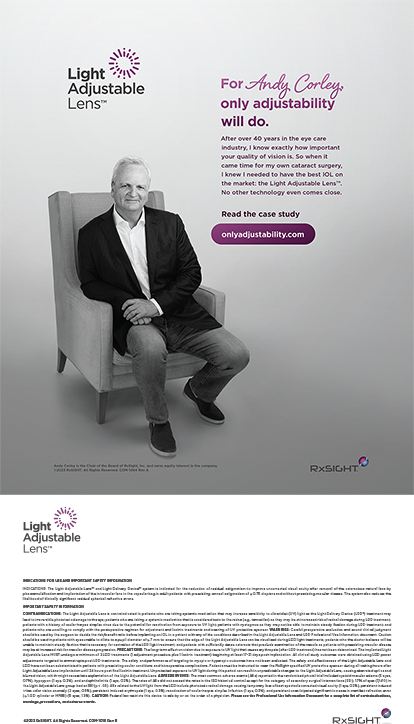
The importance of an organization’s website depends on the goods and services being offered. For example, restaurants can forego a website and instead easily publicize their menus and hours of operations and share images of their featured dishes for free on Facebook. By contrast, ophthalmology practices cannot—and should not—rely on a social media account to brand and market their services.
Websites were once used as e-brochures for health care organizations—a place where interested users could read more about the organization’s services. Today, websites (should) provide much more information than would be shared in the text of a brochure. A well-designed modern website offers 24/7 access to interactive educational and branded content.
Aside from creating a custom environment to promote goods and services, a quality website can improve brand awareness through search engine optimization. The more technically sound a website is, the more likely it is to rank highly on search engine results. The higher the website’s ranking is, the more clicks and subsequent site traffic that site generally receives.
Operational efficiency can be improved by a quality website that allows users to educate themselves on their own time. This decreases the amount of education required at the practice before, during, and after an appointment. The more informed and engaged a patient is, the more efficient practice operations become.
BRANDED CONTENT
A critical element of a well-built website is branded content. This customized content includes web copy, photos, and videos. Color schemes and designs should be unique to the brand. Creating these elements successfully requires the development of a coherent strategy and an investment of resources. Purchasing cheap stock photos or copying text from other websites isn’t building a brand. This cost-cutting approach is likely to cost an organization in the long run.
Search engines quickly differentiate unique content from duplicate content. Search engine spiders crawl sites looking for unique content that best matches a user search. Duplicate content is flagged and often removed from the results altogether, which can seriously damage website traffic and, subsequently, brand reputation.
Developing branded content may not be cheap or quick, but it doesn’t have to be complex or expensive. The magic of building a brand is achieved through establishing and executing a protocol in a unique and united way.
Establishing a strategic calendar that details the when, how, where, and what of branded content creation is a great starting point. If an organization doesn’t document and track ongoing efforts around content creation, how can that organization determine the performance of those efforts? Relying solely on a third party to create branded content can produce poor-quality results. An organization must be actively engaged in the creation of its own branded content.
USER INTERFACE AND USER EXPERIENCE
User interface. The term user interface (UI) refers to the screens and visuals that enable a person to interact with a product or service in a digital environment. It is what users see when they look at their computer monitor or smartphone screen. A UI designer considers icons, buttons, colors, fonts, spacing, and images. The goal of UI design is to present a brand’s visual assets on an interface in a consistent, coherent, and aesthetically pleasing manner.
It takes users about 0.05 seconds to form an opinion about a website and decide whether they like it and whether they’ll stay or leave.1 A brand style guide establishes parameters that must be met for content to be considered branded. Sharing visuals that don’t adhere to a brand style guide is arguably the fastest way to damage the organization’s image.
User experience. The term user experience (UX) refers to the interaction between the user and the interface (screen). Navigation is central to UX design. Online users expect to move seamlessly throughout a website and explore content that interests them. The best websites have an easily accessed main menu and present content in friendly, concise portions. Continuous maintenance and frequent updates to optimize the UX are key (see A Page Out of Apple’s Playbook).
A PAGE OUT OF APPLE’S PLAYBOOK
New smartphone models and software updates are released regularly. Some readers of this article may use an iPhone 8 (Apple), but it is improbable that any of them is using the first-generation iPhone, which was released in 2007.
It is important for businesses that rely on digital applications to maintain a quality product. Continuous maintenance and frequent updates are essential to optimizing the experience of prospective and current patients who interface with your practice’s website.

SECURITY AND COMPLIANCE
A practice’s website should never be a finished product. The best health care websites are in a constant state of maintenance and updates. Not only is a neglected website likely to be unappealing, but it can also be at risk of a data breach (ie, cyberattack) and of falling out of compliance with federal regulations.
Cyberattacks. Common security vulnerabilities include fillable forms and submissions (eg, contact and appointment request forms, search queries, patient portals). They are access points for malware breaches.
Health care websites are particularly vulnerable because attackers can leverage sensitive information found in patient health records. Plug-ins are installable applications designed to enhance or extend the capabilities of a website, and they can provide protect against these vulnerabilities. (Editor’s note: For more on how to protect your practice from cyber threats, see “Cybersecurity for Ophthalmologists”.)
Federal regulations. Practices are expected to be aware of these regulations and to update their websites as necessary to remain in compliance. Otherwise, the practice may become subject to fines, penalties, or other consequences.
1. 27 eye-opening website statistics: Is your website costing you clients? Sweor. Updated January 20, 2022. Accessed May 16, 2022. https://www.sweor.com/firstimpressions




